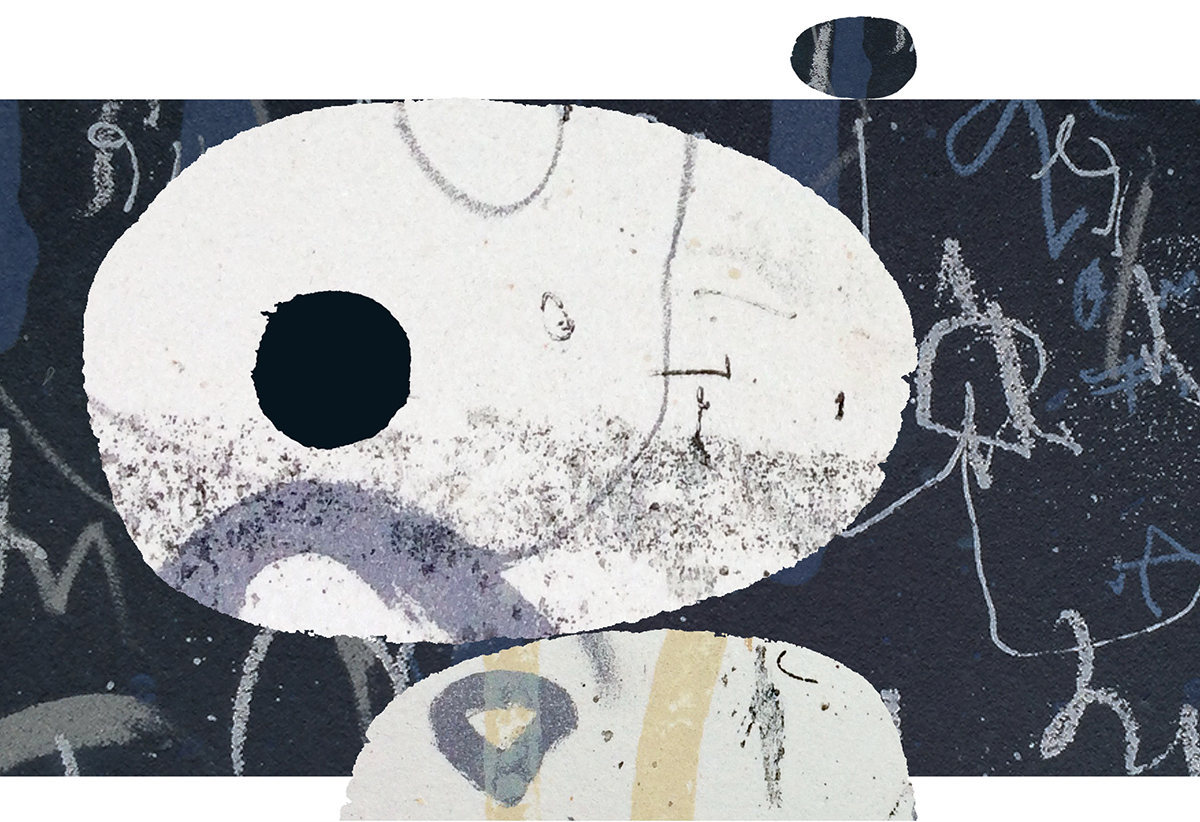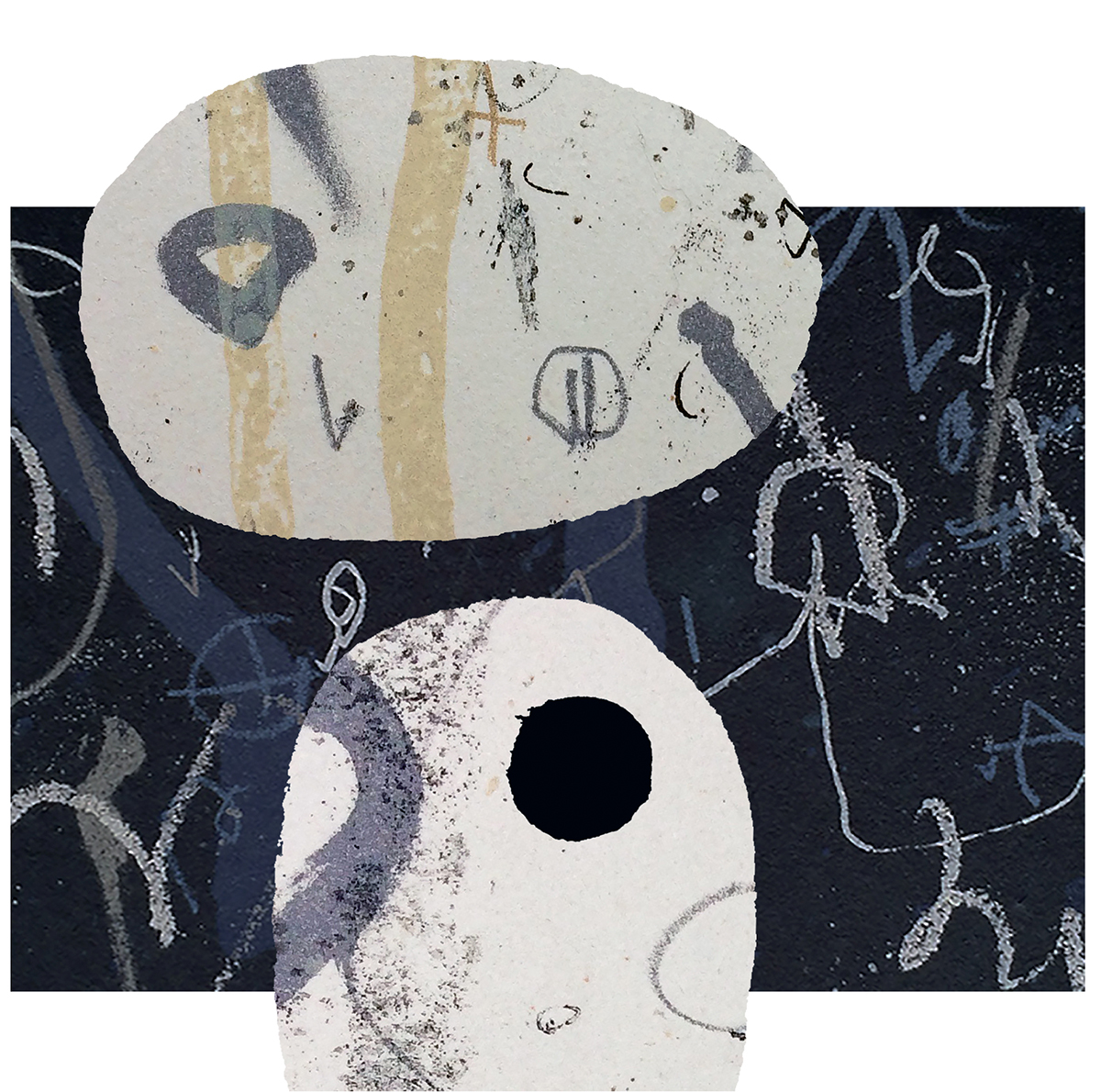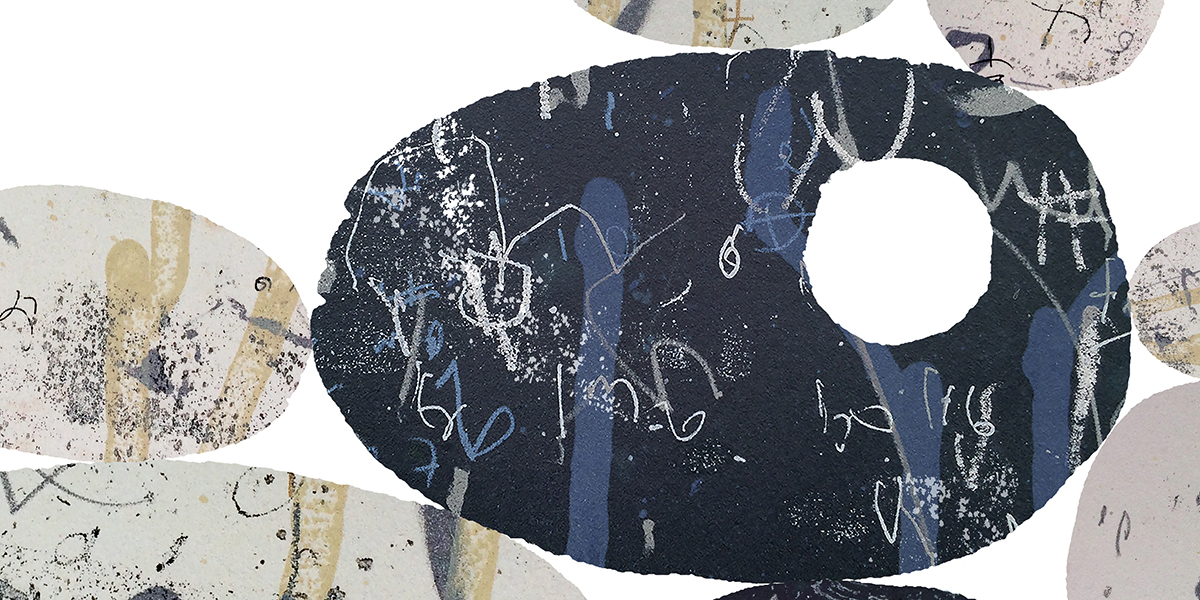In the Eye of the Hagstone
Under the Spell of Flint on the Sussex Coast
Words: Alex Woodcock | Illustration: Lucy Grant
A flint pebble with a naturally occurring hole – a holed stone or hag stone – is easy enough to find on the beaches of East Sussex. Long-time collector and admirer of these stones, Alex Woodcock heads to the chalk cliffs of the South Downs to explore their origins, folklore and his own connection to the locality.
It becomes my beach again in October. Over the summer I lose it to swimmers and late night barbecues, wet dogs and families behind wind-breaks, gangs of seagulls prowling for chips. Then it cools, the pebbles start to gleam with drizzle, and this strip of shingle between the tarmac grey of the seafront and the steel grey of the sea empties. Today it welcomes me back with stillness, without horizon, the sky a blank dome of seaweed-flavoured air. Even the stones, grey, brown and black, register my steps with only muffled echoes.
I say ‘my beach’ but the reality is I haven’t lived here for over twenty years. Until January I was an infrequent visitor. Two years before, I became restless. I left my job and moved west. I went back to university, completed a course, got a job, moved again, lost the job, ran out of money, the last just before Christmas – one of those moments when the scaffolding that underpins daily life tilts, shifts and collapses. I wasn’t sure where else to go so I came back to where I grew up, square one. And here I am, some months later, at nine o’clock in the morning on Bexhill Beach, breathing in the damp air, looking for holed stones.
The geology here is unstable: sandstone underpinned with clay to the east, chalk threaded with fissures to the west. Heavy rain or heavy seas can have catastrophic results, a strong wind turning the waves into ferocious chisels, their salt edges sharp and merciless. The nearby medieval village of Bulverhythe was all but washed away by the 1700s, leaving only the church on the hill to fall further into ruin. Winchelsea, further east, suffered a similar fate, Edward I rebuilding it on higher ground inland. At Birling Gap on the South Downs the seven coastguard cottages are now four, one lost only a few years ago, their number diminishing as the water eats into the cliffs and removes the land from beneath them. Chalk doesn’t stand a chance. But as it crumbles and falls it releases the hidden jewels formed deep within, uneven and ancient nodules of black glass: flint.
Flint is something special. Even here, battered and rolled along the coast a few miles from its source, it often retains its white calcium-carbonate coat, a striking contrast to the charcoal-black interior. Where it has been chipped or otherwise broken there is a characteristic pattern of fracture known as ‘conchoidal’, the word derived from the Greek word for mussel shell, konchē, with which the radiating lines fanning out from the striking point share a similarity. Sometimes there are other colours inside, patches of grey, almost fossil-like impressions. While the formation of flint within the sediments that become chalk remains a mystery, the occasional impressions of sea- urchins or corals suggest a silica-rich ooze, formed around the remains of dead sea creatures. Millions of years later, as the flint nodules fall out of the cliffs, the white outer will eventually be lost to the constant rolling by the waves and the flint will appear as a pale grey pebble, its only tell the dull clang underfoot or any chips or breaks. Or holes.

Depending on which chalk region of the country you are in, a pebble with a natural hole in it is known as a hag stone, an adder stone, a ring stone or a witch stone. They tend to occur in flint, and as the names suggest there is a more than a passing association with the supernatural. Historically they were believed to repel witchcraft and any disease caused by spells or the evil eye. This may have developed from their use to protect against nightmares, an early record of which occurs in a fifteenth-century charm, although well into the twentieth century folklorists recorded them draped with a red cloth or tied with red ribbon and hung above beds for just this purpose. In East Anglia the practice had close connections with horses. In The Pattern Under the Plough (1966) George Ewart Evans recalls a number of incidences of farmworkers in the early 1900s hanging holed stones in stables, sometimes tied to a piece of iron, to prevent the horse from being ‘hag-ridden’ in the night. The addition of iron was believed to confer additional potency in repelling evil influences.
There were other uses. In Dorset around the same time, fishermen used the holed stone as a protective amulet. A boat was believed to be witched if it failed to bring in a good haul when others did so, understood to be the result of not having threaded a holed stone through the rope used to bring the boat up onto the beach, when coiled up and dry. To dispel the bewitchment a mackerel stuck with pins would be placed in the stern hatch on the next launch. The twentieth-century Sussex writer Cecile Woodford recorded that her grandmother, a midwife and healer, used holed stones to cure children’s diseases and prevent adults catching them.
All of this lore was unknown to me when I started to pick up holed stones. I can’t remember now how it began or when, but wherever I’ve lived they’ve started to appear. Slowly at first, a single one here and there, before long piles of them on shelves, on windowsills, beneath the record player, sometimes en masse in cardboard boxes. They creep into my paintings. I doodle them unconsciously on scraps of paper. I can’t remember not knowing about them, not seeing them on the beach, not stopping to look. But recently I’ve become a bit sniffy about them, only allowing myself to take back the ‘best’ one from a given walk. This often finds me spending a good ten minutes deciding which to discard and which to keep, then breaking my own rule and keeping two, or even three. Sometimes I don’t walk on the beach at all, sticking resolutely to the seafront path to avoid having to face this kind of decision. I like the ones that look like miniature sculptures by Barbara Hepworth, about the size of my hand and worn by the sea into smooth ellipsoids, the hole offset in a pleasing asymmetry. But they are infrequent finds. I have a hunch that there are better ones to be found further along the coast, closer to the chalk cliffs – today’s destination.
I walk west to pick up the train at Cooden Beach, about a mile or so away, my eye distracted from the pebbles by the autumn tide’s rich strandline. One part of the beach is particularly good: drying clumps of bladderwrack; a mermaid’s purse (the egg case of a ray); a blue rubber glove; a red plastic bottle; the tail of a lobster, picked clean and resembling a section of a suit of armour; a steel toe-capped boot (left foot); a branch from a tree; bundles of multi- coloured nylon twine; another glove, yellow; two cans of lager, crushed and torn open; the shell of a horseshoe crab; a limb of pale brown kelp; some fish bones; a knitted grey glove; another steel toe-capped boot (right foot); the sole of a flip-flop.
I board the train and cross the Pevensey Levels in the company of two other passengers. Until the 1800s this was underwater, only the ‘eyes’ (from the Old English for island) – small rises of clay, each big enough for a few houses or some livestock – peeping above the water. Northeye, Southeye, Manxeye. The tiny chapel dedicated to St James at Northeye was rebuilt in the thirteenth century and served by a priest until the sixteenth, after which it fell into ruin. The stone was gradually robbed out and reused by locals. In 1857 an artist recorded its last standing section of masonry, the drawing later engraved and published in the Sussex Archaeological Collections. This showed a sorry piece of masonry top heavy with vegetation, ‘the walls ... composed of flint boulders and very thin bricks’, its rubble core exposed, a small window like an open wound. Two years later even this had gone, and by the time the twentieth century rolled into view only the foundations remained – a shadow in the pasture.
At Eastbourne I walk through the town. Last time I was here it was summer, there was a delay in my journey so I left the station and walked to the seafront. It was crowded and hot, the high tide forcing people to sit closer together than they might have done otherwise. I sat on a bench while a small slick of ice-cream oozed across the pavement by my foot and felt old, out of place, a childless observer of speedboats, arguments, palm trees, thinking of the flints steadily rolling beneath the waves. I moved to a busy café and drank a cold half, feeling self-conscious as I pulled out a notebook to write something about the pastel-coloured hotels.
But this is surface stuff, flotsam. I know better. I was twelve years old when a giant fin whale was washed up near Galley Hill (formerly Gallow’s Hill). It was enormous, dead before it beached, the underside of the sea suddenly revealed. That something so extraordinary could live in the ocean and then emerge, through a succession of chance events, onto the beach, stayed with me. No, this coast is a wilderness as much as any other, with its own laws and ways, in thrall to its own obscure languages – the pull of the moon, tidal ranges, longshore drift. Nothing is as it seems.
‘In everything one treads on’, wrote the founder of Surrealism, André Breton, in his mystical mid- twentieth-century work, Arcanum 17, ‘there is something that comes from so much farther back than mankind and which is also going so much farther’. Breton, writing in 1944 in a rented cabin near the foot of the enormous Percé Rock on the northeast coast of Canada, could not ignore the long cycles of geology that its shadow confronted him with each day. Trying to find peace in the midst of war and personal tragedy he ended up drawn to this stretch of coast and stayed for three months. There is some comfort in geology I guess, cold, but direct – get on with it, it says, your lifespan is nothing. True enough. As the first line of Hikaru Okuizumi’s novel The Stones Cry Out has it, ‘Even the smallest stone in a riverbed has the entire history of the universe inscribed upon it’. The hag stone tells the more human side of this history perhaps. Of fear, suspicion, disease and its healing, of countering dark magic, of minding the gap between the living and the dead, natural and supernatural. Its very form is a negotiation between the visible and the invisible, a combination of stone and air, presence and absence, at home in this transient place where land and sea meet, a place of limbo and secret, slow transformations.
Rain is coming in. Walking along the seafront I’m heading straight into it, blown by a southwest breeze. Empty benches, each with a dedication – ‘In loving memory of Charlie and Evelyn Parker’, ‘Bill and Doreen Dibb-Fuller, loved and remembered’ – line one side of the seafront path, bench after bench after bench like an ancient processional route of the dead, each one in a uniform dark cherry-wood stain. Coming closer now the slumped edge of the chalk, sombre beneath its green cloak. The sea is spitfire blue against the cliffs; the agapanthus flowers in the border faded and going to seed. To shelter from the rain I sit with my back against one of the high wooden groynes on the beach. I notice holed stones all around me almost instantly, some with fossils in them – in one a coral, in another a streak of white resembling the vertebrae of a fish. I put them into my bag. More stones.

There is an urban legend regarding holed stones around here. Aleister Crowley, the famous occultist, is supposed to have cursed Hastings or Eastbourne. The details are almost irrelevant, but that there is a curse – and a cure – appears to be the important bit. The gist is that unless you take a holed stone from the beach, natives of either town are compelled to return, wherever they may move to. I guess that this applies to this whole stretch of coast even though I’ve gathered loads of them, and, apparently, haven’t managed to leave. I think there’s a deeper undercurrent to this story, however, the linking of the holed stone with a curse (and who better to trace the origin of it to than Crowley, especially as he spent his last years in Hastings), an expression of something intangible, almost mythical, about place. If you don’t take a stone you are forgetting where you started and forced to come back and go over old ground. Perhaps at some level, forgetting who you are.
At the foot of the cliffs the pebbles are black flint and cream chalk. Tiny black spiders of seaweed are scattered across them, creating the effect of a dark speckled carpet. There is an odd atmosphere made by the additions to the beach here: a mound of dark boulders placed as sea defences; a groyne missing most of its planking, the vertical posts steadily marching into the sea. It has something skeletal about it, a ruinous and industrial air like a wartime Paul Nash landscape, but with its suggestion of ribs also a hint of life. The waves work their way around the posts with minimal fuss, the dark boulders, black posts and smoked glass pebbles contrasting with the supercharged opaque green water and lending it an unexpected luminosity, as if it were rolling over a giant, seabed lightbox.
I turn to face the cliffs. The chalk is worn and cracked into sections that appear loose, as if they could fall out at the slightest touch. I don’t want to get too close. Then I see a sign, a plank fixed to the cliff with faded lettering in black paint. It appears in a small vertical cleft in the rock that forms a miniature cave. The Holy Well, it says.
This is unexpected. I’m aware of holy wells in the southwest but not here, in Eastbourne of all places, on the beach. Moving closer I can see a glimmer of moving water. Pebbles are pushed up into the cave, though there appears to be a boundary of large boulders in a semicircle in front. I wonder who comes here to look after it, move the stones and paint the sign. They haven’t been for a while.
I squeeze under the overhanging rock and kneel on the chalks and flints. The trickle of water runs out of the cliff and disappears inches from my knees. I suddenly feel self-conscious; there were other people on the beach, they’ll see me kneeling by the cliff, perhaps they’ve come to see the holy well. I hear a scatter of stones behind me and jump, but there is nobody there. I edge out and stand up. The only people here are a family in red waterproofs a couple of sections of beach away, happily skimming stones. They don’t appear to be moving my way. I have a primal urge to place a votive of some kind into the sliver of chalk water, something to quieten the pagan inside and align myself with this slanted energy. I move back, assured now that I’m not going to be disturbed but still heavy with the sense of being watched, and tuck a holed stone – one I’ve brought from Bexhill, for what reason I don’t know – into an adjacent pocket of rock. I think of the land and the water and ask it to guide me in finding the next bit to inhabit – yes, a prayer I guess – then back out into the rain and walk to the seafront. The stone-skimmers don’t acknowledge me as I pass; perhaps I am invisible now.
Ten minutes later the sun breaks out. Familiar noises weave their way into my ears; traffic, seagulls, scraps of overheard conversation. People are walking dogs and children. The pavement smells of rain. Heading back into the town I’m suddenly aware of being hungry. I have food with me, all untouched, but wait until I’m back at the station before I break into it. As I’m eating I examine the holed stones I’ve picked up. Until now I’d always assumed they were made wholly by the waves but these ones, fresh out of the cliffs, appear to have holes in them already. Increasingly it strikes me that the holed stone is a collaborative effort, the flint formed with holes or weaker areas already present that the sea then works further. This makes them a truly liminal stone, a product of the interaction between land and water, made on the beach and belonging to the beach.
The crowded train leaves the station and wobbles over the points. ‘Learn of the pine from the pine’ wrote the poet Matsuo Bashô. So too with the stones. Look at the stones and there is nothing but continual transformation.

This article was first published in Edition Two of Elementum Journal

Alex Woodcock is a writer with a particular interest in medieval art, stone carving and sculpture. A former cathedral stonemason, he holds a doctorate in archaeology. In 2015 he won the Cardew-Rendle Prize for his essay on Romanesque sculpture in Cornwall and in 2018 he won the Hugh Miller Writing Competition for poetry. His recent book, King of Dust (Little Toller, 2019) is a personal exploration of the medieval sculpture and landscapes of the southwest of England that first led him to learn to carve stone.
Alex is a regular contributor to Elementum Journal.
